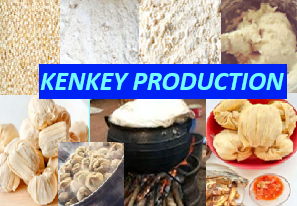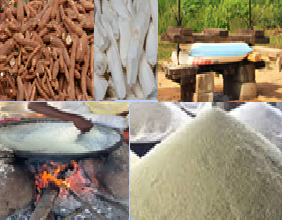How Kenkey is produced in Ghana (West Africa) and the scientific processes involved.

How Kenkey is produced in Ghana (West Africa) and the scientific processes involved.
Kenkey is a popular staple food in Ghana(West Africa).
It consists of fermented and cooked maize dough, wrapped in leaves.
Kenkey is a staple swallow food similar to sourdough dumplings from the Ga and Fante inhabited regions, but could be found in other parts of the country as well.
It is popularly known as kɔmi (pronounced kormi) by the Gas or dokono by the Akans in Ghana.
What is kenkey, and how is it made?
Kenkey is one of the major fermented foods made of ground white corn (maize).
The steps involved in the production of quality and highly economical kenkey are as follows:
- The corn is soaked in water for about three days, making sure to change the water every day without sticking your fingers in the corn.
- Once the water has been drained from the dry corn, they are taken to a mill to be ground into powdered form.
- The corn flour is mixed with water and kept for some days to allow for fermentation.
- In between the fermenting, the dough may look yellowish on the top.
- Rinse it off gently with water.
Fermentation is a metabolic process through which microorganisms such as bacteria, yeast, or fungi convert carbohydrates (sugars and starches) into alcohol, gases, or organic acids under anaerobic conditions (absence of oxygen).
It is a form of anaerobic respiration used by certain cells to generate energy in the absence of oxygen.
Process of Fermentation
- Initiation: Microorganisms are introduced to the substrate (e.g., yeast added to grape juice for wine).
- Lag Phase: Microorganisms acclimate to their environment; minimal activity.
- Exponential Phase: Rapid microbial growth and metabolism, converting sugars to fermentation products.
- Stationary Phase: Nutrient depletion slows microbial growth; maximum product concentration is achieved.
- Decline Phase: Microorganisms die off as nutrients are exhausted and toxic byproducts accumulate.
Importance of Fermentation to the Kenkey Production
- Fermentation extends the shelf life of perishable foods by producing alcohol, acids, and other compounds that inhibit the growth of spoilage organisms and pathogens.
- Fermentation adds unique flavours and textures to foods and beverages, making them more enjoyable and diverse. For example, the tangy flavour of yoghurt or the complexity of wine and beer.
- Fermentation can increase the bioavailability of nutrients and produce beneficial compounds like vitamins, antioxidants, and probiotics that support health.
- Fermented foods often contain live beneficial bacteria (probiotics) that can improve gut health and boost the immune system.
- Fermentation has been a traditional method of food preservation and preparation across cultures for thousands of years, contributing to culinary diversity and cultural heritage.
Turning the fermented Corn Dough into Kenkey
- Divide the dough into two parts once it is fermented.
- One part will be cooked, and the other will be mixed with the cooked part.
- Water is then added to the raw part, some salt, and then it is cooked.
- Once the dough is cooked, it is added to the raw dough.
- This cooked dough is called Aflata.
- Mix the Aflata with a wooden spoon to form a homogeneous dough mixture.
- The next step is to make small balls from the dough and then wrap them in the dried corn husks.
- Moulding of Kenkey into balls
- Tuck the ends in and mould or squeeze the ball together to close any large holes and cover the twisted end.
- The wrapped dough packets are placed on a wire rack above water in a large pot and allowed to boil and steam for one to three hours, depending on their size and thickness.
Several scientific processes come into play to ensure the safety, quality, and efficiency of the production process. Some of which are
Drying:
- The corn is dried to remove water from the corn to help in milling
Fermentation:
- The rise of the corn dough as a result of the action of bacteria.
- The key scientific process in preparing kenkey is fermentation.
- Fermentation is a metabolic process in which microorganisms, such as bacteria and yeast, convert carbohydrates into alcohol or organic acids.
- In the case of kenkey, the fermentation process is crucial as it imparts a unique flavour, texture, and sourness to the final product.
- The fermentation is facilitated by naturally occurring microorganisms present in the maize kernels, such as lactobacillus bacteria and wild yeast.
- Additionally, the production of organic acids such as lactic acid and acetic acid acts as a natural preservative, slowing down the growth of spoilage microorganisms and extending the shelf life of the kenkey.
Amylase Activity:
- Maize contains starch, a complex carbohydrate made up of glucose molecules.
- During the fermentation process, natural enzymes present in the maize, such as amylase, break down the starch into simpler sugars, primarily glucose.
- These simpler sugars are then consumed by microorganisms during fermentation, resulting in the production of lactic acid and carbon dioxide.
pH Regulation:
- The fermentation process in kenkey involves the production of lactic acid by beneficial bacteria.
- The lactic acid lowers the pH of the dough, creating an acidic environment.
- This low pH inhibits the growth of harmful bacteria and preserves the kenkey.
- The acidic environment also helps improve the digestibility and nutrient availability of maize.
Gas Production:
- As microorganisms consume the sugars in the maize dough during fermentation, they produce carbon dioxide gas.
- This gas gets trapped within the dough, causing it to rise and become lighter and more porous.
- The gas production contributes to the characteristic texture and volume of kenkey.
Heating/ Boiling:
- Heat is used to change moulded corn dough into the final product for consumption.
Heat Denaturation:
- After the fermentation process, kenkey is traditionally cooked by steaming or boiling.
- During the cooking process, heat denatures the proteins present in the maize dough, resulting in structural changes that contribute to the firmness and texture of the final product.




